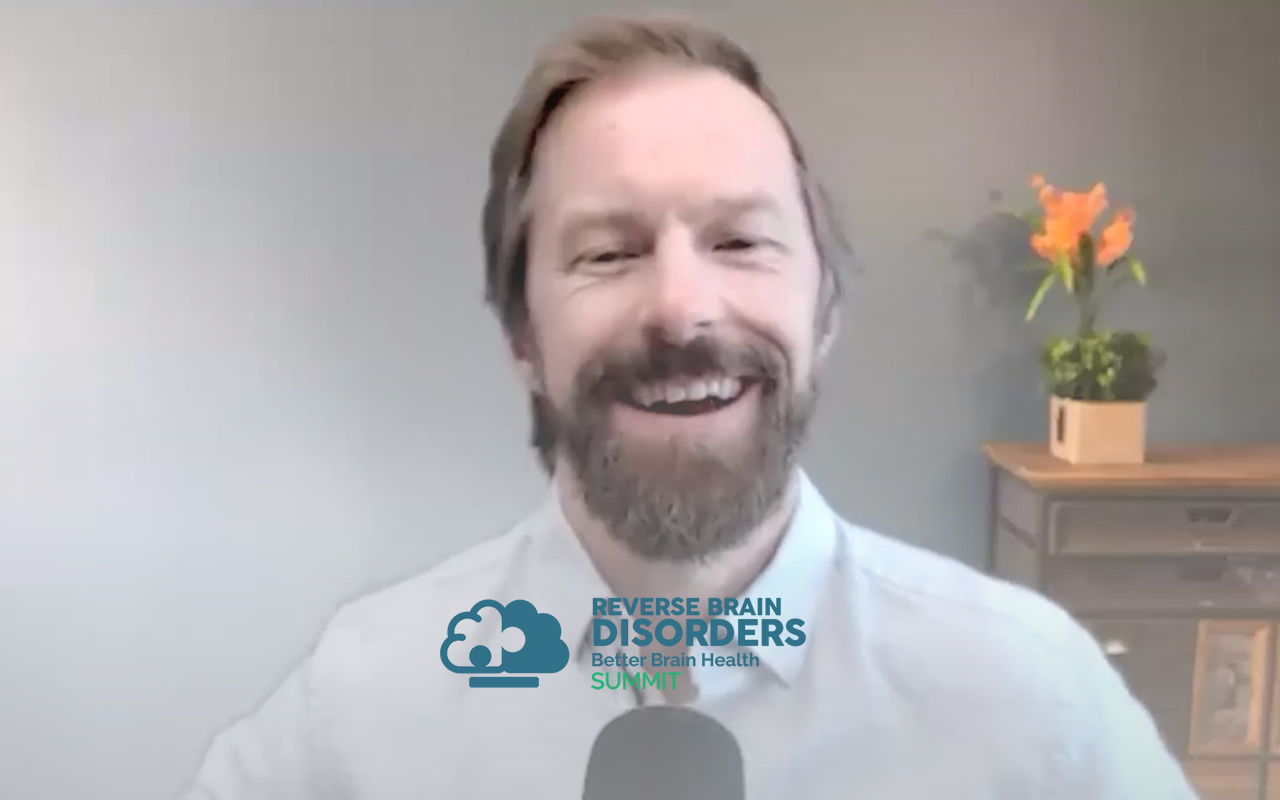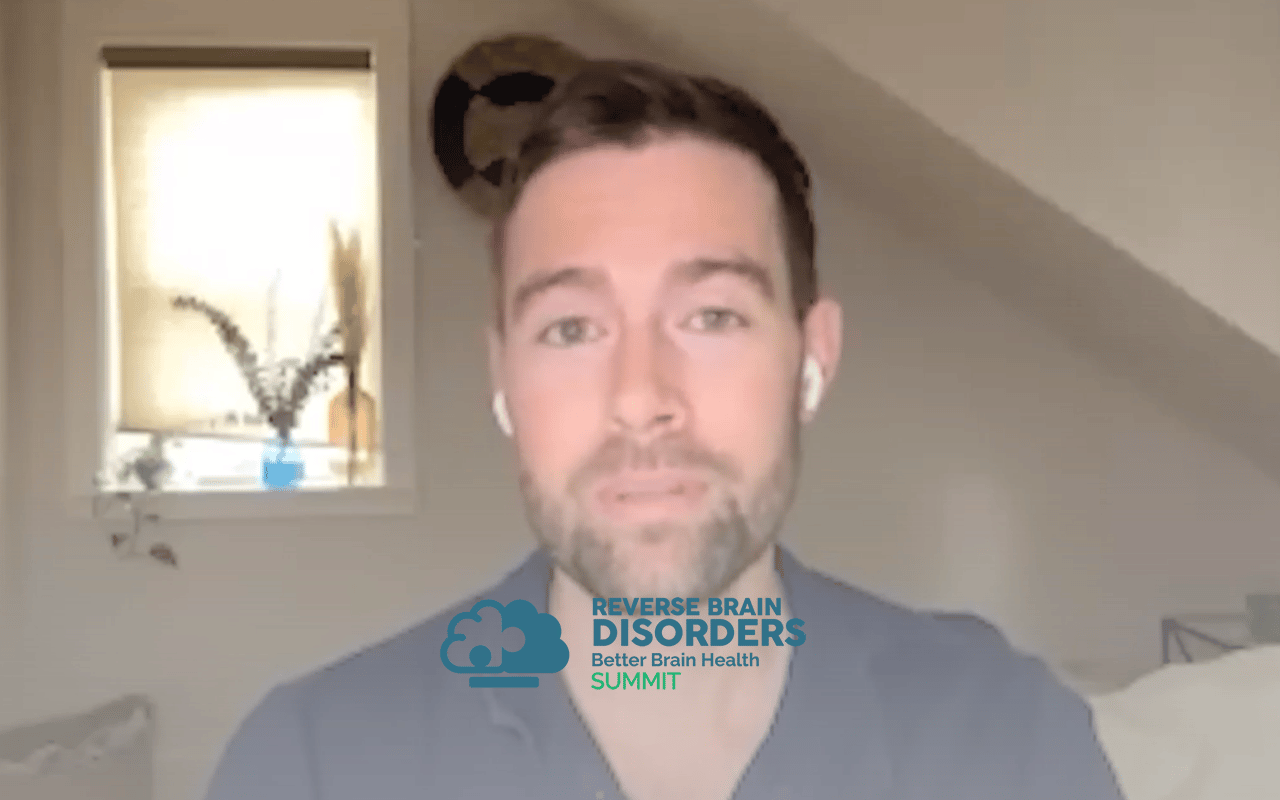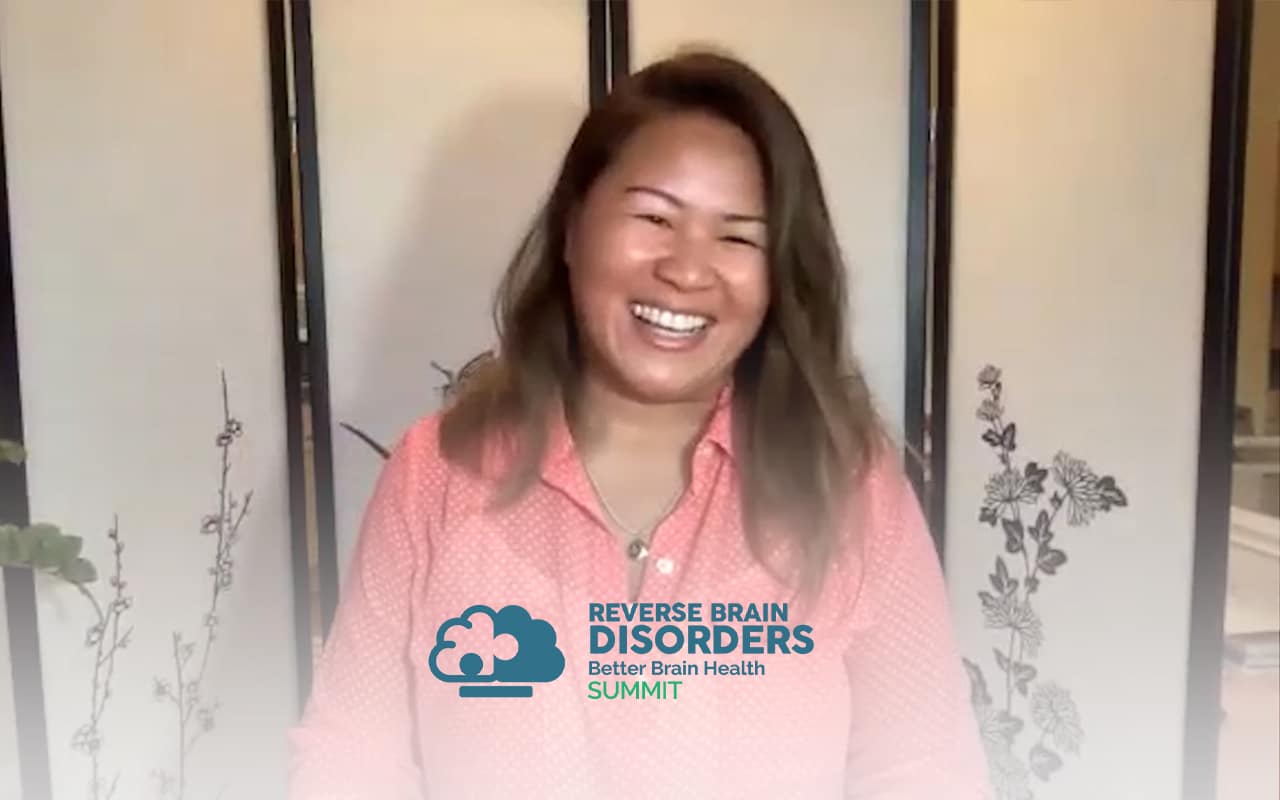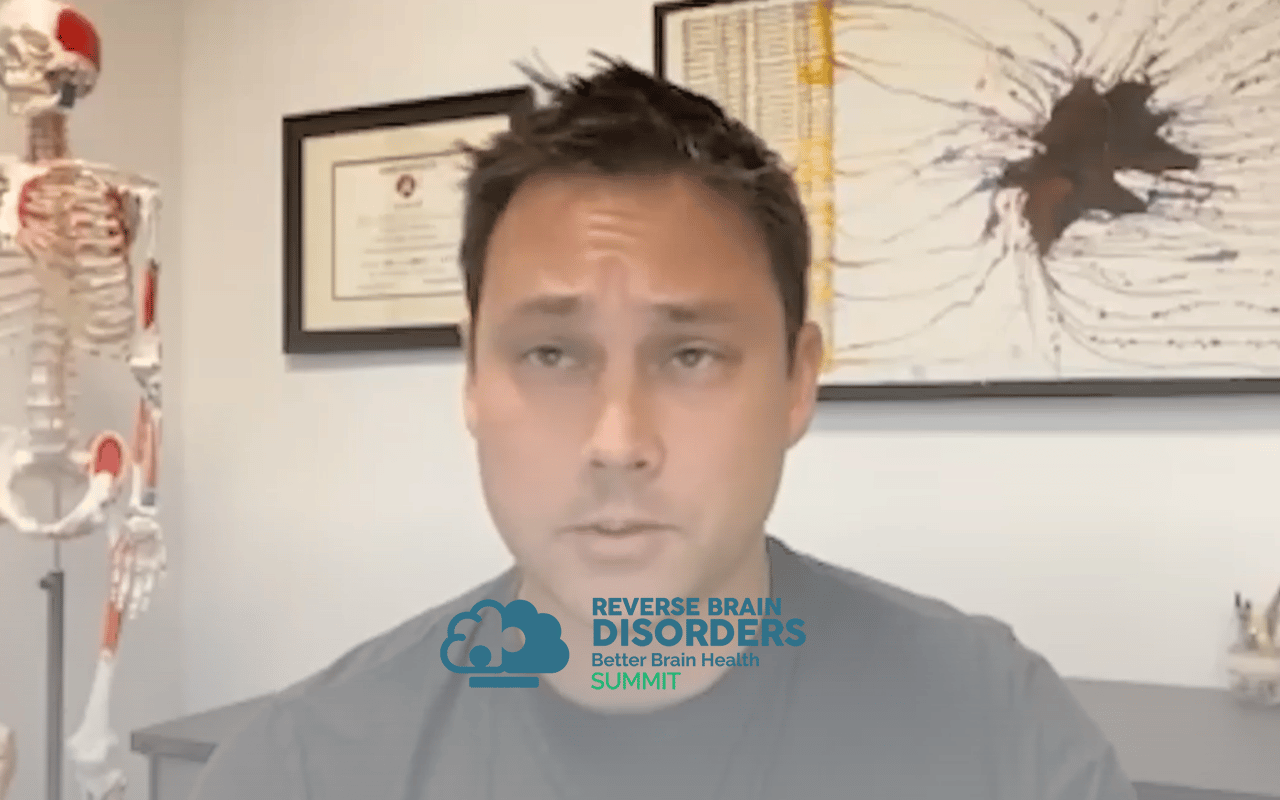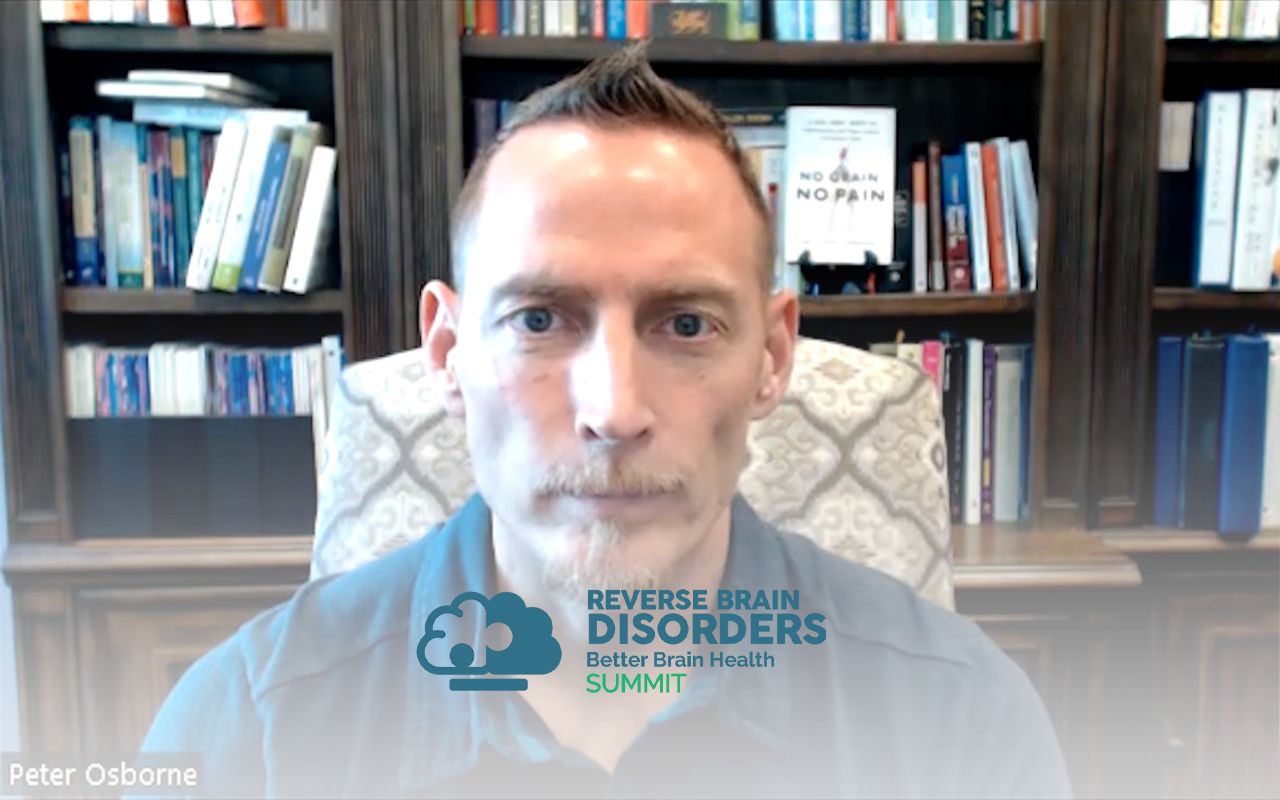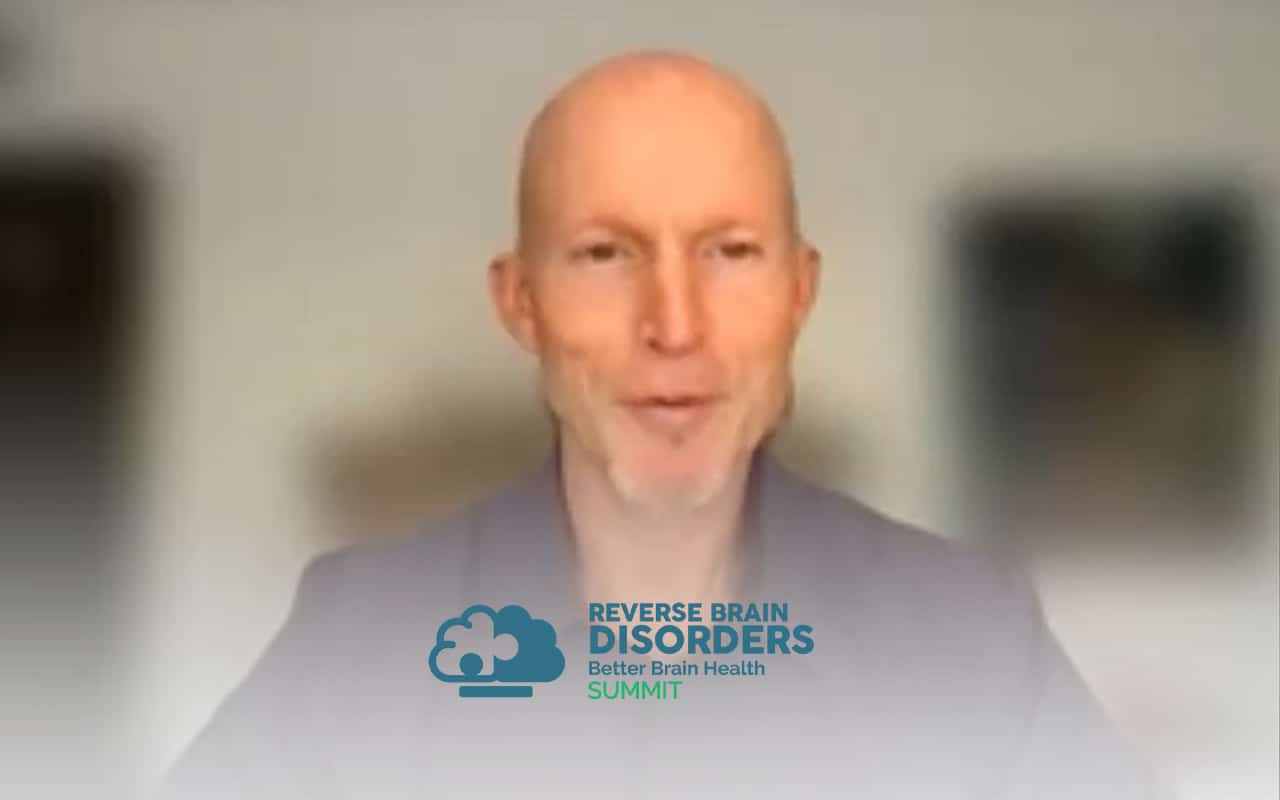Join the discussion below

Dr. Ruan is the Founder and CEO of Texas Center for Lifestyle Medicine. He devotes his career in practicing and building systems that allow for efficient delivery of healthcare. He is a board certified internal medicine physician but also have advised with companies to improve their workflow, company culture, marketing,... Read More

Dr. Tom treats some of the sickest, most sensitive patients suffering from chronic Lyme disease, tick-borne co-infections, mold illness as well as children with infection-induced autoimmune encephalitis (PANS/PANDAS). He focuses on optimizing the body’s self-healing systems in order to achieve optimal health with simple, natural interventions; utilizing more conventional approaches... Read More
- How hidden infections missed by many doctors can affect brain and memory issues
- How breathing and mindfulness is the most neglected topic of reversing brain disorders
- Why the immune system is the way to hack the body for optimal brain health.
- How Lyme disease and other infections can destroy the brain
Cheng Ruan, MD
In this segment. We talk about something super cool and interesting with Dr. Tom Moorcroft and this segment is dedicated to hidden toxicities and infections and I think it’s one of the biggest risk factors, hugest risk factors and bra mental health and memory loss and Alzheimer’s and whatnot. So, Dr. Tom Moorcroft, he’s kind of a mystery solver. He’s a global leader in solving really complex medical mysteries and his goals to really find out what’s going on with the patient and helped him really get better and involves combining the best of what medicine has to offer with a passion for the patient. And I love talking to this guy because he’s like a brother of mine and we just get along so well because our our philosophies are very similar but we’re gonna talk about infections. Some somebody called co infections which is basically multiple infections such as like Lyme disease and other infection agents as well. And he’s worked with countless amount of patients on this specifically and guided them through journeys that allow them to achieve ultimate outcomes and their health. So, Dr. Moorcroft um is uh is part of the International Line and associated disease um physician group and medical neural anatomy fellowship. He’s a doctor of Osteopathic medicine. So we’re gonna actually talk about how osteo graffiti actually relates to brain health, what that means that the structure and bodily function, our spine, our neck and our fashion, everything how that relates to really a lot of brain and mental health. So it’s going to be such a great conversation. So allow me to bring on Dr. Tom to the stage, Hey brother, welcome to the show.
Thomas Moorcroft, DO
All right, hey, thanks for having me, I’m pumped,
Cheng Ruan, MD
I am pumped as well, you know? Um now for the audience listening to this, we’ve been talking offline forever, so we’re both smiling because we kind of know what our vibe is all about. Let me kind of guide the conversation and today I kind of want to start with an area that’s a huge mystery for a lot of folk, especially myself even because I’m in Texas and what we don’t see a lot here um or what we don’t think we see a lot here are infections that are from ticks and how that really affects the brain. So let’s kind of start there and then we’ll talk about some solutions.
Thomas Moorcroft, DO
Yeah, I mean, you know, I think the one of the biggest things that we see out on the east Coast um and we’re starting to see with global climate change, really marching across the country is, is Lyme disease and other infections from deer ticks um issue being these little ticks, um a lot of people see like dog ticks and wood ticks and lone star ticks, but they’re kind of big and these deer ticks are small and we even get the knife, which is the kind of like essentially the baby or or like kind of like a Tween if you will um is kind of is the one that gives about 90 to 95% of people lime and these are about the size of a poppy seed. So when you’re traveling to the East coast or the upper midwest you may, you know, you gotta be careful of these things and they’re they’re transmitting a bunch of different organisms. And probably the most common one is uh an infection called borrelia burgdorferi, which is the bacterium. Um It’s a spiral organism that causes Lyme disease. And one of the like you’re alluding to chang one of the part things is um it leads to things like brain fog, brain inflammation, joint pain and this is the overall sense of fatigue and malaise. Um And so it’s one of those things that now now it’s differentiated itself from everything right? Brain fog, joint pain and fatigue, like so many other things, but that’s something to be aware of, especially if there’s an acute onset, say in the summer months or in the fall. Something to think about.
Cheng Ruan, MD
You know what I learned about like your fry and Lyme disease in med school is not what I’ve recently learned about. Right? And so what I learned in med school is that it can transmit these organisms, these these spiral organisms called spire Keats and these are kids do a whole lot of damage on systemic areas in the body. And in fact we called Lyme disease, the great mimic er and mimics a lot of other disorders. Um But the way that was taught to diagnose it um is not necessarily the right way. So I would kind of want to get your take on what is the conventional way of diagnosing it And what do you what do you do?
Thomas Moorcroft, DO
Well, the first thing we’re looking for is a known tick bite, right? Everybody wants you to find the tick, depending upon which research you read anywhere from 40 to 60% of people truly remember a tick bite. Right? So not that many and clinically when you start to see people who have been missed in the past, it gets closer to 20% of people actually remember the tick bite and part of it because it’s no see um like I was saying like a poppy seed, the other part is the in medicine, we’re always looking for something that’s path a pneumonic, right? It’s this it’s this word that we use to describe. If you see this, it’s a slam dunk of Lyme disease and that’s called an erythema migraines rash or most people know it as a bull’s eye rash. The problem is this only happens in about 50% people. Um the CDC says about 70 but it’s more when you actually read the medical research, it’s right again around 50%. The issue being with this era theme of migrants bull’s eye rashes that only about 30% of all the era theme of migrants rashes are bull’s eyes meaning there’s a central clearing and red rings with other lines of clearing in between that looks like a bull’s eye. Most of them are like red purple pockmarks. It just looks like you bumped into something and it’s this weird streak in a different place. So most of the that’s why a lot of the rashes are missed is people are looking for a bull’s eye and it’s actually just like you know, somebody took a brush stroke and put some red purple on
Cheng Ruan, MD
You see that I didn’t know. So-
Thomas Moorcroft, DO
We’re all looking for the bulls eye, right?
Cheng Ruan, MD
Yeah. No, absolutely. And so um but even on blood work there’s a lot more new things that are really out there that didn’t really know about. So can we go over what that looks like?
Thomas Moorcroft, DO
Yeah, I mean you know um in the blood work the problem is if you were all looking for like this two tier testing so called it’s like we do an antibody screen that’s positive and then we confirm it with the western block. Um so they’re just two different types of blood tests where we’re looking for our body making antibodies to lyme disease. And the big issue is that if you order the test too soon or too late it can be negative so you can get a false negative. Um And so a lot of times right within the first 2 to 4 weeks after a bite you’re not even going to see anything in the blood the other problem. So so essentially you get infected and you’re already sick and but if you do the blood so many times that I hear is this looks and sounds like Lyme disease let’s start your treatment will do the blood test if it’s negative like two days later they call them and stop the treatment. And so here’s where I see a lot of people is that’s their scenario that’s when they were seen and then they started to get better.
They stopped the treatment because the blood test was negative and now all those symptoms crept back in and now I see the months or years later and the problem is when you start the antibiotics prior to your body making the immune the antibodies we can actually blunt or stop the antibodies from being made. So now that I’ve given you a half fast treatment and I’ve and now I can actually prevent one of our main diagnostic indicators. So really Lyme disease um and this isn’t like in Harrison’s textbook of Internal medicine and we say it all the time but people forget it is lime is a clinical diagnosis and we support it with our laboratory data because the problem is if you now let’s just take a different person, someone got bitten by a tick they had the bull’s eye rash, we did nothing. You know they were just like at a rash it went away if you were to track their I. G. M. Response to Lyme disease and I. G. M. Is just one of those antibodies it would go naturally would go up and then it would go down over time then it would go back up and it would go down. So over time an untreated individual will show a variety of responses on the blood work and depending upon which month you check them in they may be positive or negative even though they truly have the infection.
Cheng Ruan, MD
Wow okay so that’s complicated. But in in in your in your words and I think in two talking about Lyme disease it is a clinical diagnosis and training is not necessarily easiest in the world. And I feel like a lot of people with with lime a lot of the neurocognitive symptoms of line. Um They kind of get poo pooed on by a lot of the people in the medical industry doctors as well. Um And it’s not really until they find you know someone like yourself that’s able to diagnose them. But let’s go back to Spyro Keats inspired by the way it’s just a spiral structure of the bacterium. And Lyme disease is one. Our borrelia burgdorferi which causes Lyme disease is one of them. Um There are other spire Keats as well and they behave very similarly um uh triple needham paladin which is syphilis. The sparky that causes syphilis is very similar. In fact if you actually look at the disease progression is actually quite similar as well. And there’s other spiral Keats that the dentists find in the plaque samples and the paradigm dizzy. That’s far more common as well. That’s also having very similar effects. Especially with the brain neurocognitive issues. Why are all these organisms around? And how do you think is really the mechanism for it to cause a lot of the brain issues and mental health issues?
Thomas Moorcroft, DO
Yeah, I mean I think it’s a really great question and one is sort of that spiral nature like for whatever reason they kind of corkscrew into tissue. But I think one of the big things about Spyro Keats is their their tissue organisms. This and going back to your other question about lab did the biggest problem with looking for Lyme is we’re looking for our antibody response. We’re not able to easily find the organism because it loves tissue. So the big tissues that we see in Lyme disease being affected are the gut, sometimes the brain muscles and the brain, the brain is a great soft tissue for these things to migrate in. And um when you ask like you know why it gets in these things, it’s interesting that when you look at syphilis, it’s exquisitely sensitive to penicillin and other antibiotics. Right? Lime, on the other hand is not there’s actually video and also like still photography evidence of taking a spire key exposing it to uh an antibiotic. And these things will roll up like kind of essentially inside out. Roll up into a ball. So it’s like an armadillo. And now the normal antibiotics don’t penetrate it. And then they can sit in a test tube after they take the antibiotic out for anywhere from a couple of weeks upwards of over 10 months and still come back out and be an intact parakeet. When you look at the data, we know that borelli aspira Keats have been found in ticks that are over 13 million years old. Right? So I mean, how many people know this? Right.
And rockets real infections like anna plasma cece and Rocky Mountain spotted fever. Their distant cousins have been found over 100 million years ago. So these organisms are well adapted to um being um persistent. And this is one of the things that I think that I see a lot of and how it relates to the brain. It’s a tissue organism. It likes to move in. But the other thing is they’ve been around a long time and they’ve realized one of the best strategies is to reproduce slowly and to go under the radar. So you see a lot of these organisms hiding in biofilm, like you said within the plaques of the teeth. Also lime can create biofilm. Many other organisms can and they have these round body forms that armadillo we talked about but they all end up reproducing slowly and hiding in areas where the immune system can’t get too easily like in parts of the brain, in parts of the heart and it’s almost like a smoldering infection. So in the beginning, a lot of times you’ll have an acute infection, but a lot of them almost like get past that, then it goes into this chronic low level smoldering. It’s almost like you’re trying to start a campfire with like wet pine needles and leaves, right? All you do is create a lot of smoke.
And so these things are just they’re they’re not trying to overwhelm your body, knock it out there, just trying to have a long term food source. And so they get into the brain tissue and then they reproduce slowly and they’re not trying to really picks your body off too much, but they’re just trying to get what they need and that leads to this ongoing sort of smoldering inflammatory response. And then in cognitive stuff, which is really crazy. We look at things like if you have a spiral kettle illness, meaning syphilis or Lyme borrelia burgdorferi, you can have a five to a 10 fold increased risk of alzheimer’s and if you have chlamydia pneumonia, which a lot of people run into just in our environment that gets into your nose that can also create a chronic infection there, which can lead to a 4 to 5 fold increased risk of alzheimer’s. So it’s kind of like, I think part of it’s what they’re doing with that smoldering infection. And then the other part is the physiological changes that kind of interfere with our detoxification pathways which allow it to stick around. That then lead to us having these brain problems.
Cheng Ruan, MD
Yeah. So, so it’s just sticking around. It’s like, hey, I don’t want you to discover me. So I’m gonna do my thing in the corner here and I want to survive years and like whatever happens you sorry,
Thomas Moorcroft, DO
It’s crazy. Like it really is. It’s like they live in antibiotic privileged places, immune system, privileged places and that privileged where it just means your medicines and your immune system can’t get there. And they just figure how to go and hide and they are, they’re just chilling in the corner creating just enough havoc to be a pain in the ass.
Cheng Ruan, MD
That sounds terrible but other organs, like there’s other organisms that behave very similarly. You know, talking about line is so similar to talking about like mold and mycotoxins always locked in a way these biofilms and the airway and we have a lot of that down here in Houston after hurricane harvey. And so you know, it’s it’s it’s behaving very similarly. What I find that is fascinating and interesting is that when I talk to you guys like yourself and other people that treat lighting disease. The way that we treat like mole toxicity is almost identical and we actually start with structure. So let’s kind of get into that for a second. So people are thinking what is structure, what does that mean? So the structure actually means that a lot of times our body’s detoxification or um systems are dependent on the way that we hold ourselves up, our symmetry of the spine or curvature of the spine, how tight our muscles are, the lymphatic system was drained and stuff and the lymphatic system and stuff like that. Can you talk about how that’s implicated in the desertification? A lot of these organisms?
Thomas Moorcroft, DO
Yeah, I mean I just think this is so critical because so much of all the conversations you and I have had really focused on going back to sort of the what are the root causes of health and healing and and I love saying that hey all these people come what’s the best brain detox supplement you can give me I gotta I gotta optimize brain detox by taking stuff and I’m like part of it is you want to open the drain and so if we look at the way the brain detoxify there’s a system called the glimpse static system. Right? So if I step back one second in our arms and our legs, in our in our chest we have a lymphatic system which most people are familiar with kind of the drainage system of the body and in our arms and our legs we need to have movement and muscle contractions in our thorax or abdomen and our pelvis to really move that low pressure lymphatic system and drain out all the dirty water. If you will, we need to have pressure gradient changes, which is why so many of us focus on really good optimal breathing mechanics as well as keeping the ribs open. You know and getting the physical structure sort of more your posture better in our brain. It’s actually we have a system That has a fluid wave that goes from our arterial side through the brain to the Venus side and then it starts to drain through a variety of pathways.
One of the pathways that you and I talk a lot about with mold and just Alzheimer’s and other things is through the nasal emphatic and upwards of 30% of the nasal lymphatic drainage or the brain detoxification comes to the nasal passageway. So if we look at that and then we go to uh where’s it go from there? Well once it comes out of the nose it goes to the deep cervical chain of lymphatic. So now we’ve gone from this fluid wave in our brain back down to the structural mechanical. And when we look at we talk about the head forward posture or muscle, shoulders up neck tight. I know I hear you talk a lot about the sternal Clyde um asteroid muscles out here and the scallions. Any of these muscle tightness in our neck can actually slow down and back up the drainage from the brain and if we go back one other step our brain detoxification pathway like I said the arms and the legs and even the neck bit of gravity, lots of muscle contraction, the rest of its breathing. Our brain detoxification pathway primarily functions in deep slow wave sleep. So one of the things where you see lyme and mold interfering so much with and leading this so much brain fog, cognitive dysfunction is they disrupt our autonomic nervous system. We get much more fighter flight and then we’re unable to sleep as deeply and we’re not able to sleep as deeply. We’re not moving that fluid out of the brain as well. So it’s kind of like but again it’s the whole system, it’s not like, oh I only need to sleep, it’s like I need to sleep. I want to move my body. I want to nourish it.
Get a lot of water in there, get the neck and the muscle and the shoulders chilled out so they can fully drain and you do that. You don’t have to worry as much about what’s the best supplement you can use that to supercharge. It may be but you really have to have it all open. Um and one other part I want to make sure I throw in here for Chiang. I think it’s so important is when you look at what lime does to the brain. Um we talk a lot about fight or flight mechanism for sympathetic. Right? So when I talk about the sympathetic six and that fight or flight is I can win. So I always I love sabertooth tigers for some reason. So I’m sitting at the campfire hanging out with my friends having dinner. Sabertooth tiger shows up. So I went from chilling out, resting, digesting social engagement and joy. I went to oh my God and in a split second I have to decide I can fight this saber tooth tiger and I have a high probability of winning or I need to run away and I have a high probability of running away and that’s typically the way we think of sympathetic and parasympathetic. However there’s another part of our parasympathetic nervous system that says, hey what if the saber to tiger grabs me in its mouth and now I can no longer get away and that’s that freeze state. So no longer can I fight or flight and actually win. I the only way I can win is to play dead. Right?
And what’s really interesting is when you look at the physiology of this, how do we get people out of it? They need to understand gesture. They have to understand intonation of our voice and facial expression. Now going back to Lyme disease, if you look at a spec scan a type of brain scan of a person with lyme, the centers of the brain that are responsible for us being able to understand those gesture intonation and facial expression are also the ones that lime likes to go to an adversely effect. So now people are like why is lime so hard to get rid of? Well, one of the reasons is it’s been around forever and it’s really slow growing and it knows how to hide the other one is the parts of the brain that it attacks essentially are the ones that we need to be working properly in order to get better from it.
Cheng Ruan, MD
Here’s the thing that bothers me the most. Just referential to type in the area of the brain and that freaks me out a little bit. It’s just thinking about the monster eating the temporal lobe that that I have my brain dude,
Thomas Moorcroft, DO
it’s true, it’s like temporal lobe, anterior cingulate gyrus, parts of the parietal lobe, I mean all of these things that allow us to understand. So if I if we complete the kind of this concept, we’re kind of talking about polly vagal theory and what we’re saying is we need to be able to understand that we’re safe in order to heal and the problem is most of us are safe and we can heal yet lime, the way impacts our brain makes us makes it easier for us to believe that we’re not safe. So when we’re not safe, we’re not focused on healing, we’re focused on being safe, we’re focused on, I’m not trying to heal when I’m trying to save myself from the saber to tiger. And the problem is whether I’m stuck in fight or flight or I’m stuck in freeze, all of those are associated with lower immune system function, greater gastrointestinal disruption because we don’t want blood going to our gut when we’re trying to live, we’re trying to save our lives. So it’s a complex mechanism you know.
Cheng Ruan, MD
It is and you know people are listening to this. I don’t want you guys to lose. So I was like oh my gosh, I have lime, I’m gonna die and my temple will be eaten by this monster. But the point here is that there’s so many things that we can actually do. So let’s focus on the things that we can actually do. Right? So we talked about, yeah, we talked about you know, increasing the lymphatic journalistic lymphatic and movement. Um but let’s talk about the role of like mindfulness and meditation and how big do you think that role is in combating these infections?
Thomas Moorcroft, DO
Yeah, I mean I just this is so incredibly important. This is a two way street that we’re talking about. So even if lime is affecting those parts of your brain, you have the power to even more greatly affect those parts of the brain, right? And that’s the beauty of the way the body functions. The body knows how to heal that part of the brain better than you cognitively do. So I would say. And when I had Lyman DiBiagio sis I got treated for 10 days, I was sick for the next eight years took me about 4.5 years to get better. But the 1st 70 to 75% of my healing was all movement based yoga meditation, mindfulness. It was like I was, my back was against the wall, I didn’t know any, I had gone to all the doctors, they give me all the medicines that didn’t work and I was finally like I give up like I give up with this more medicine I said but I have a goal like I know what I want to do in my life. I’m recently married, I wanna have kids, I want to go outside, I can I can envision myself playing outside. So I had a really clear goal, I’m skiing and mountain biking, playing with the dogs, playing with with my kids and my wife and everything.
So what I did was I focused on what I wanted and I had this kind of ah ha where it’s like oh if I spend more time focusing on what I wanted than some of my mindset started to shift and then when I started to look and then I got I was like you know in a year 70% better and then I needed that last 30% I needed help from doctors to get over the line because they’re infections but it was you have so much healing potential and from the mindset perspective I used yoga to move me to the point where my nervous system was able to calm down and I could sit for meditation and become familiar because for me meditation has so many different definitions. I love the one which is to become familiar with. So I would challenge you to become familiar with the state that you want to be in because so many of the people I see with lime or mold or even mass cell activation syndrome, they focus so much on the state that they’re currently in there. Kind of like in a negative meditation. I have chronic Lyme, I’m a limey or a moldy, so they’re focused on what they don’t want. And so it’s a self fulfilling prophecy, you get more. So I asked people to focus a little bit more every day on what they want and become familiar with that state. Um, there’s a simple exercise that because the problem is this is all well and good until you try to do it and that’s what I found out. Right, It’s so hard when you, when you don’t feel well to do it so right, It’s crazy.
It’s like, hey, listen to Dr. Tom, he’s been better for, you know, 12 years now. So you know, but what I found was I needed to make it simpler and our body doesn’t want us to complicate it, it wants us to breathe, it wants us to eat simple foods and one of the neatest mindset pieces I found because I studied with all kinds of people, you know, bob Proctor mary morrissey, you know, looked at some Tony robson like everybody, you name it. I’ve just devoured this stuff to find out why when I focused on what I wanted, I got more of that and I got less illness. And what it really boils down to me is start somewhere simple. One of the most powerful exercises that I use now and I use with all my patients is at the end of your day when you’re all wound up and you know, or many people are wound up and saying, I can’t fall asleep, let’s practice going to sleep right. And we start that with writing down three things that went well during the day. And it doesn’t, it doesn’t matter how big or small and in fact I don’t even want it to be big, the smaller is the better because when you start to look at the nuanced loveliness in your life, you start to notice more and more of that. And it should take about three minutes. You write down three things that went well from the day. And if it’s a bad day, just write down a few lessons that you took from it. And now the key is write down three things that are going to go awesome tomorrow because so many of us. When I ask you to write down something that went well or focus on what you want, your like automatically, the conscious mind starts to think of all the reasons why that’s not gonna happen. So I don’t want you to limit yourself.
So you write down three things for tomorrow that are being great and b and then you go to bed and when you fall asleep, you kinda dissociate from the conscious mind and then your subconscious is open to God or the universe or life force, whatever words resonate with you. But that universal potential and you start to come up with all these new ways to make your dreams come true. And you wake up the next morning, you read the three things that went well from yesterday, the three things that are gonna be badass today, and then you just do that every day and the first day, it’s a little weird. The second day you’re like, wait a second, this is already happening. The third day, you’re like, oh, this is really happening a week or two into it, you’re like, now your evening practice becomes gratitude based. And when you get gratitude into your life because you’re just going, oh my God, there’s so many good things, I’m so grateful for this. Now. You start to have with that gratitude, your heart starts to open and your heart rate variability increases whether you monitor with a ring or an ear clip or whatever or a headband doesn’t matter, it’s still working and heart rate variability going up means you’re more in your heart, which gets you out of that state, that Lyme disease may have put you in and it gets you more into that parasympathetic state of social engagement, rest and digest. And now you’re becoming more chill right before bed and you set yourself up for deeper and deeper sleep and all you’ve done is notice three things that happened today and you plan three good things for tomorrow.
Cheng Ruan, MD
That’s amazing. The fact that we have the ability to, to improve 70% of this and then for like 30% doctors, that’s not, that’s not common knowledge, you know, and, and I’ll tell you, you know, um, a lot of patients and especially when I first see them and you know, I sense a lot of activity and stuff that’s saying there, I just pause it for a little bit, Hey, you know what, what, let’s, let’s pause the negatives for a second. It just seems to be quite a bit, what are some three things that are awesome to happen to you this week? A lot of like, I don’t know, you know, like there’s, there are things, you know, you have a loved one next to you that’s sitting there, that’s supporting you. That’s a great thing. You have, you know, you have a house and stuff like that. So it’s, and, and then whenever people start thinking about the positive that they’re no longer no longer like this, they become more relaxed and sitting back in the chair and I was like, hey, congratulations, We just did the first level of detox, which is relaxations. Lymphatic reflexes actually drain into the rest of duct and illuminate. So that was detox. And like what like, yeah, thoughts are your first detox, you know,
Thomas Moorcroft, DO
and it’s like the opposite is true too. So none of this should be hard. We all know that like negative thoughts are normal, right? And I have a lot of people who are like challenged by the fact that like, oh well you’re doing it better than me or I’m not like that. I’m like, no, no, no, no, here’s the thing, right? The negative thought is a protective mechanism. When you initially have an a negative thought about a situation, it’s a protective mechanism that’s been developed over millennia where your body is doing its best, your body is not betraying you right now, your body is actually doing its job for you. Now. The beauty of like my dog, my dog will be like, whoa, what’s that? Right? And he’s on guard and then he goes, oh it’s not a thing. So he’s cool with it, right? And then he just shakes it off and does one of those things and he’s great. But humans have this other higher part of our brain which allows us to make a choice. We have a choice to say I’m gonna stay focused on the negative or I’m gonna stay focused on the positive or I’m gonna just go back to neutral, right? Like my dog and the thing is in this day and age, there’s so much of the negative around us. That’s why we create a habit of just refocusing on the good stuff too.
It’s not, I just want people to understand your body is not betraying you and you’re not doing it wrong if you notice negative crap in your life because that’s normal. It’s the amount that we we allow ourselves to focus on it that gets into the pathology. So yes, you did not develop the habit of focusing on negative, probably all on your own. Some of its your family, some of it’s your society. I mean look on the news, the news, why does why is negative cells so? Well, it’s because it triggers our survival mechanism and it catches our attention and it spikes are cortisol being chill and hanging out does not spike your cortisol does the opposite. So it’s less addictive. It’s not like an adrenaline rush. But when we calm it all down we go, let’s become more familiar with that state too. Because the fighter flight should be momentary and then we should practice this other state of calm. And so your body is doing a great job for you. In fact, when you when you have the awareness that you’re in a negative state, not only do you know, two main things here. One is that your body is kicking asks for you, it is doing the best it can for you. And the other thing is you have a choice of what to do next. And and the first way in taking that healing detox process that you just talked about is to be aware of it. And the only difference between someone who sounds like they know how to do it really well. A meditation guru or master is they notice it a little quicker than and they go back to it a little faster than you did. But a week ago they didn’t write, it’s just the practice that allows you to become aware and go back to that state that you want your nervous system to be in.
Cheng Ruan, MD
I think we agree that the people listening to this and their loved ones have the ability to heal that super caesar expectations. They just haven’t discovered yet. Right? Yeah. And I think a lot of us in our in our arena and integrative and functional health and especially a lot of doctors have gone through very similar journeys and that’s what a lot of, a lot of us have really relied upon is sort of the the mindfulness and the belief systems, aspects of it. We talk about belief systems and cognitive impairment other areas in in the in the summit. Um but everyone agrees is that that belief system, you know, it’s it’s stem from somewhere I interviewed Dr. Bruce Wexler, he is Yale and Harvard trained psychiatrist and researcher and he’s one of the first humans in the world that relate together the fact that psychiatry and neurology are not separate, that emotions are actually back in the eighties, right?
And he, his goal was always to change psychiatry towards that route. I interviewed Doctor Daniel Amen, who’s on the exact same mission as well on his latest book. You happier was actually all about that. And and so and and these these these these two phenomenal individuals that have been around for a while, they’ve been in psychiatry for a very long time. We all agree that the experiences are the things that can heal the brain experiences that that can be something that revisited, and you spin it around from a negative to positive, that starts the healing process and from the brain physiology side, as Dr. Wexler pointed out, he was doing, like, functional MRI’s on people’s brains, I guess. You see the physiologic changes whenever the experience our changes and that’s what’s super powerful about all this, you know, and the and I’m so grateful for you to to mention that as well, and it’s very hopeful, you know, it’s very hopeful people, we can do so much for ourselves, we just don’t know, you know,
Thomas Moorcroft, DO
right? Well, you know, I, I love hearing everybody coming to the same conclusion, because, like, people like, oh, but how how did when are you gonna get to how you treat Lyme, I’m like we’re talking about supercharging your immune system, Supercharging your detoxification system, supercharging your brain and giving you control back. It is not a system where you need another doctor and another pill, it’s a system where you have a lot more control than you may realize and what’s really interesting about what you’re just saying about the other guys, you know, because we all know them right, where no of them, I mean they’re just such pioneers. Um I remember a couple of studies um where they one study uh Andrew Newberg from the universe. I think the University of pennsylvania’s and Nora radiologist, I’m sure you may have come across, but it’s like he took buddhist meditators and Franciscan nuns and had them get into their highest levels of meditation or prayer and you know, then they did scans of the brain and what they found was they both had association cortex in the parietal lobe kind of calmed down, right? So they’re kind of feel, you know, being associated with the desk and the chair or the whatever calmed down and they got really right prefrontal cortex got really connected and what was really cool was they both had essentially the same exact biochemical experience, but the Franciscan nuns had the experience of God directly speaking to them and the buddhist meditator had an experience of being connected with the universe, but biochemically and physiologically in your brain, they had the exact same thing.
So what we know is the mindset that we bring into the situation Will color like the lens that we put on will color our experience. The other really interesting experience I’ve had. And I don’t know, I keep telling this everybody cause I’m like, I gotta find the paper, I found it in a yoga mindfulness. Um you know, is a reference like 15 years ago and I can’t find the paper again. But they had three people playing a game remotely right, one of the first remote games and they’re throwing a ball back and forth and they’re throwing the ball, throwing the ball, throwing the ball. And at one point the researchers asked two people to leave the other personnel and only throw the ball back and forth between those two. And so at the end of this, you know, whatever a minute session, they ran them down, they did functional M. R. I. And they found that the person who was left out their anterior cingulate gyrus, you know, has a lot of things to do with emotion and anger, like lit up, they felt dissed they were completely left out.
They felt horrible that they were left out from the other two people. And they were just like social losers, right? And the interesting thing though was there were no to other people, it was just a video game that one person was playing in the researchers. So so when we look at this real or perceived trauma is not just something really happened to you? You thought something happened to you? That’s how powerful your thoughts are. You can have a conversation with God, you can be connected with the universe or you can decide that other people left you out or you can decide that you’re sick or you can decide that you’re well, we have all the evidence to show that this is true, just like Dr. Ayman and Wexler we’re talking about. But the bottom line is those things are nice and complicated. We can look at the studies and blah blah blah in the end, all you have to do is decide what you want and then make it a conscious habit to focus on that more times than not. And it’s a gradual wonderful process. But you have that much power that you can change your biochemistry.
Cheng Ruan, MD
So as we wrap this up, we start talking about infections and ended up in belief systems and people think they’re not related, they really are. And then that’s the beauty of our bodies and our body has an amazing ability to to generate health. That’s the cool part. Right. And so um and so let’s just wrap it up for a bit. How do how do people find you first of all?
Thomas Moorcroft, DO
Yeah, I’m at originsofhealth.com and youtube and facebook I conveniently kept it the same. So just Origins of health on instagram, Dr. Tom Moorcroft and super happy to hear from everyone,
Cheng Ruan, MD
Awesome. And are there any parting words for audience before we close it off?
Thomas Moorcroft, DO
Yeah, man, I mean, I just want to say thanks for the opportunity and I just think that all of this stuff that we’ve talked about um these infections, they sound complicated and from a medical perspective they can be but you have the ability to change your physiology, optimize your physiology to make yourself the world’s worst bacterial fungal and viral host, right? You can your body is this amazing self healing mechanism and we talk about this body, mind. Spirit unity and kind of like you were saying with the psychiatry and the neurology all being one thing, this is just one continuum of all the aspects of your life. So sometimes you might need a medicine or an herb or maybe even a detox protocol or to go see a structural therapist. So much of it is what you focus on and what you do at home. And I’m really, my mission is to let people know that they are in charge of their ship and we’re all here to help you and support you. There’s so much great research going on, but it’s what you hold closest in your heart. So focus on that thing, get really clear on the stuff you would love to do in your life and just know that you do deserve it. You do deserve to hell and you can heal and we’re all here to help you.
Cheng Ruan, MD
And thank you for being a badass. Thank you all right. We’re gonna close it off, and I want to thank you for coming on once again and um go find Dr. Tom Once again is the originsofhealth.com is what it is. Originsofhealth.com. Alright, Peace.
Downloads

